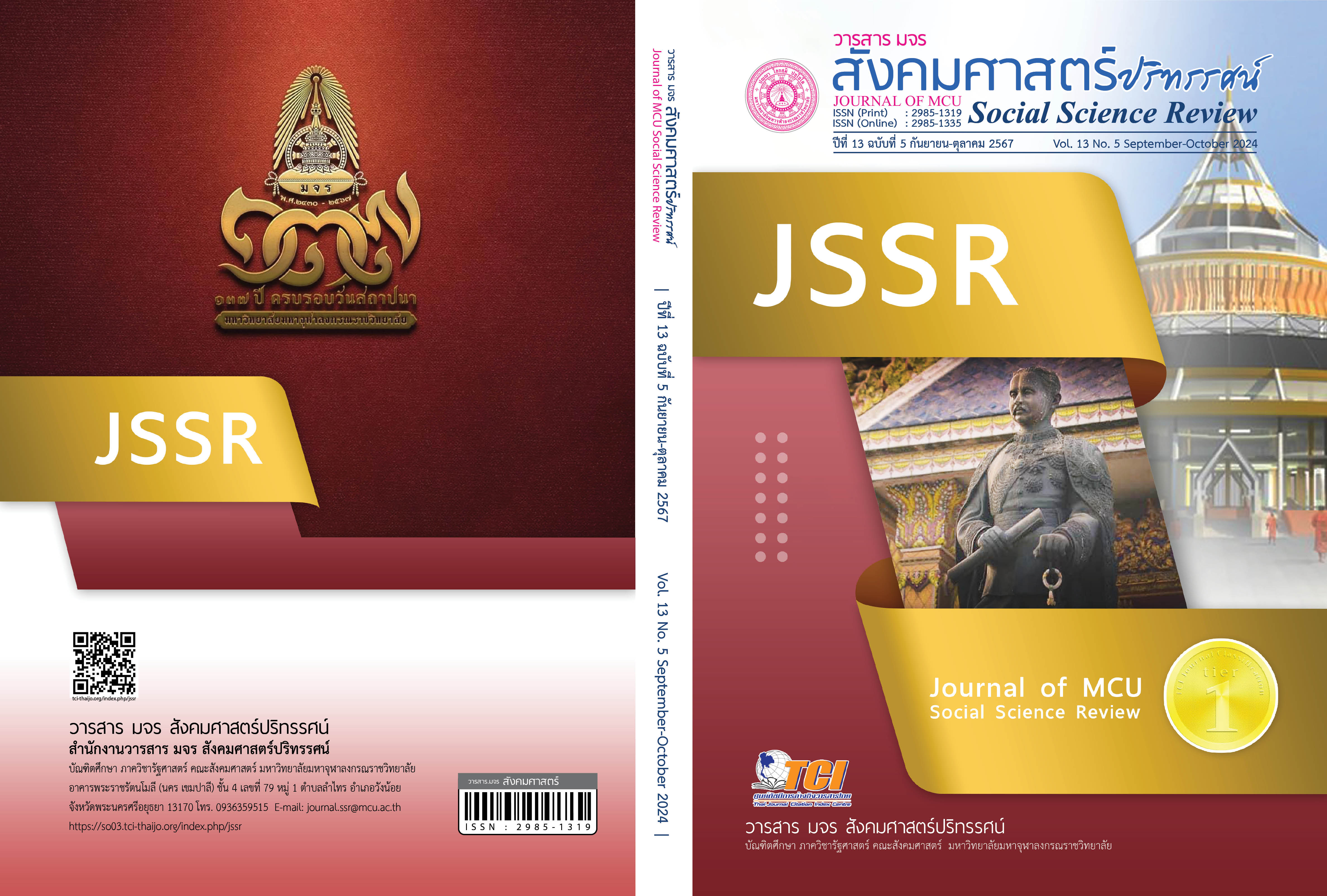โมเดลความสัมพันธ์ระหว่างภาวะผู้นำการเปลี่ยนแปลง พฤติกรรมการสร้างนวัตกรรมในการทำงานกับผลการปฏิบัติงานของบุคลากรการไฟฟ้า ฝ่ายผลิตแห่งประเทศไทย
คำสำคัญ:
ภาวะผู้นำการเปลี่ยนแปลง, พฤติกรรมการสร้างนวัตกรรมในการทำงาน, ผลการปฏิบัติงานบทคัดย่อ
บทความวิจัยนี้มีวัตถุประสงค์ 1. ศึกษาระดับความคิดเห็นของภาวะผู้นำการเปลี่ยนแปลง 2. ศึกษาโมเดลความสัมพันธ์ระหว่างภาวะผู้นำการเปลี่ยนแปลง 3. ศึกษาเส้นทางอิทธิพลของภาวะผู้นำการเปลี่ยนแปลงพฤติกรรมการสร้างนวัตกรรมในการทำงานกับผลการปฏิบัติงานของบุคลากรการไฟฟ้าฝ่ายผลิตแห่งประเทศไทย เป็นการวิจัยเชิงปริมาณ
กลุ่มตัวอย่างเป็นผู้บริหารของการไฟฟ้าฝ่ายผลิตแห่งประเทศไทย จำนวน 316 คน และได้มาด้วยวิธีการสุ่มตัวอย่างแบบแบ่งกลุ่ม เครื่องมือที่ใช้ในการวิจัยครั้งนี้ คือ แบบสอบถามภาวะผู้นำการเปลี่ยนแปลง พฤติกรรมการสร้างนวัตกรรมในการทำงาน และผลการปฏิบัติงาน มีค่าสัมประสิทธิ์แอลฟ่าครอนบาคของแบบสอบถามเท่ากับ 0.95 วิเคราะห์ข้อมูลด้วยสถิติบรรยายและสถิติการวิเคราะห์เส้นทาง
ผลการวิจัยพบว่า ภาวะผู้นำการเปลี่ยนแปลงมีอิทธิพลทางตรงต่อพฤติกรรมการสร้างนวัตกรรมในการทำงาน (β=0.64, p< 0.05) ภาวะผู้นำการเปลี่ยนแปลงมีอิทธิพลทางตรงต่อผลการปฏิบัติงานของบุคลากรการไฟฟ้าฝ่ายผลิตแห่งประเทศไทย (β=0.05, p< 0.05) พฤติกรรมการสร้างนวัตกรรมในการทำงานกับผลการปฏิบัติงานของบุคลากรการไฟฟ้าฝ่ายผลิตแห่งประเทศไทย (β=0.84, p< 0.05) และภาวะผู้นำการเปลี่ยนแปลงมีอิทธิพลทางอ้อมต่อการปฏิบัติงานของบุคลากรการไฟฟ้าฝ่ายผลิตแห่งประเทศไทย (β=0.54, p< 0.05) และภาวะผู้นำการเปลี่ยนแปลง พฤติกรรมการสร้างนวัตกรรมในการทำงานกับผลการปฏิบัติงานของบุคลากรการไฟฟ้าฝ่ายผลิตแห่งประเทศไทยมีความสอด คล้องกับข้อมูลเชิงประจักษ์ (CMIN/DF=1.43 GFI=0.97 AGFI=0.95 RMSEA=0.04 RMR=0.01 CFI=.0.99)
เอกสารอ้างอิง
การไฟฟ้าฝ่ายผลิตแห่งประเทศไทย (กฟผ.). (2562). โครงสร้างองค์กร. สืบค้น 20 มกราคม 2564, จาก http:www.intranet.egat.co.th
_____. (2566). คู่มือค่านิยมการไฟฟ้าฝ่ายผลิตแห่งประเทศไทย. สืบค้น 5 มกราคม 2564, จาก https://issuu.com/egat.pr/docs/firm-c-manual-for-employee
ธานินทร์ ศิลป์จารุ. (2555). การวิจัยและวิเคราะห์ข้อมูลทางสถิติด้วย SPSS (พิมพ์ครั้งที่ 7). กรุงเทพฯ: บิสซิเนสอาร์แอนด์ดี.
สำนักงานคณะกรรมการนโยบายรัฐวิสาหกิจ (สคร.). (2562). รายงานการเงิน พ.ศ. 2562. สืบค้น 20 มกราคม 2564, จาก https://shorturl.asia/7HRGf
อารีย์วรรณ อ่วมตานี. (2554). การวิจัยเชิงคุณภาพทางการพยาบาล. กรุงเทพฯ: โรงพิมพ์แห่งจุฬาลงกรณ์มหาวิทยาลัย.
Bass, B. M. (1985). Leadership and performance beyond expectations. New York: The Free Press.
Bass, B. M. & Avolio, B. J. (1990). Developing Transformational Leadership: 1992 and beyond. Journal of European Industrial Training, 14(1), 21-27.
____. (1991). Transformational Leadership Development: Manual for the Multifactor Leadership Questionnaire. Palo Alto, C.A.: Consulting Psychological Press.
_____. (1994). Transformational leadership and organizational culture. Journal of Public Administration, 17(1) 112-121.
Emmerik, I. J. (2008). It Is Not Only Mentoring: The Combined Influences of Individual-level and Team-level Support on Job Performance. Career Development International, 13(7), 575-593.
Jong, D. J. P. & Hartog, D. D. N. (2008). Innovative work behavior: Measurement and validation. Retrieved March 20, 2020, from https://shorturl.asia/Bvl4Z
_____. (2010). Measuring Innovative Work Behaviors. Creativity and Innovation Management, 19(1), 23-36.
Koopmans, L. et al. (2011). Conceptual Frameworks of Individual Work Performance a Systematic Review. Journal of Environmental Medicine, 53(8), 586-866.
_____. (2014). Construct Validity of the Individual Work Performance Questionnaire. Journal of Occupational and Environmental Medicine, 56(3), 153-171.
Marquis, B. L. & Huston, C. J. (2017). Leadership role and management function in nursing: theory and application (9th ed.). PA: Lippincott, William, & Wilkins.
McCarthy, A. M. & Garavan, T. N. (2001). 360° Feedback Process: Performance, Improvement and Employee Career Development. Journal of European Industrial Training, 25(1), 5-32.
Momeni, M. et al. (2014). The Effect of Employees Self-Efficacy on Innovative Work Behavior at Social Security Organization Employees in Ardabil Province. Kuwait Chapter of Arabian Journal of Business and Management Review, 33(2536), 1-4.
Nabil, H. et al. (2017). The Impact of Leadership on Creativity and Innovation. International Journal of Humanities and Social Science Invention, 6(6), 55-62.
Scotter, V. J. R. & Motowidlo, S. J. (2000). Interpersonal facilitation and job dedication as separate facets of contextual performance. Journal of Applied Psychology, 81(1), 525–531.
Sonnentag, S. & Frese, M. (2002). Psychological Management of Individual Performance. UK: John Wiley & Sons.
Stoffers, J. et al. (2019). Towards a Sustainable Model of Innovative Work Behaviors’ Enhancement: The Mediating Role of Employability. Sustainability,12(1), 1-25.
Tidd, J. & Bessant, J. (2014). Management innovation (5th ed.). West Sussex: Wiley.
ดาวน์โหลด
เผยแพร่แล้ว
รูปแบบการอ้างอิง
ฉบับ
ประเภทบทความ
สัญญาอนุญาต
ลิขสิทธิ์ (c) 2024 วารสาร มจร สังคมศาสตร์ปริทรรศน์

อนุญาตภายใต้เงื่อนไข Creative Commons Attribution-NonCommercial-NoDerivatives 4.0 International License.
เพื่อให้เป็นไปตามกฎหมายลิขสิทธิ์ ผู้นิพนธ์ทุกท่านต้องลงลายมือชื่อในแบบฟอร์มใบมอบลิขสิทธิ์บทความให้แก่วารสารฯ พร้อมกับบทความต้นฉบับที่ได้แก้ไขครั้งสุดท้าย นอกจากนี้ ผู้นิพนธ์ทุกท่านต้องยืนยันว่าบทความต้นฉบับที่ส่งมาตีพิมพ์นั้น ได้ส่งมาตีพิมพ์เฉพาะในวารสาร มจร สังคมศาสตร์ปริทรรศน์ เพียงแห่งเดียวเท่านั้น หากมีการใช้ภาพหรือตารางหรือเนื้อหาอื่นๆ ของผู้นิพนธ์อื่นที่ปรากฏในสิ่งตีพิมพ์อื่นมาแล้ว ผู้นิพนธ์ต้องขออนุญาตเจ้าของลิขสิทธิ์ก่อน พร้อมทั้งแสดงหนังสือที่ได้รับการยินยอมต่อบรรณาธิการ ก่อนที่บทความจะได้รับการตีพิมพ์ หากไม่เป็นไปตามข้อกำหนดเบื้องต้น ทางวารสารจะถอดบทความของท่านออกโดยไม่มีข้อยกเว้นใดๆ ทั้งสิ้น





